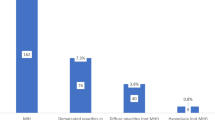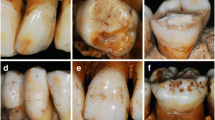Abstract
Aim: This was to study the impact of molar-incisor-hypomineralisations on developmental defects of enamel (DDE) prevalence. Additionally, to present the prevalence of DDE and molar-incisor-hypomineralisations (MIH) in 12-year old children in Bosnia and Herzegovina (BH) who live in an area with low natural fluoride content in the drinking water (less than 0.1 ppm). Methods: As a part of the oral health study of 12-year-olds, information about DDE and MIH were collected from a random sample of 560 children. To study the impact of MIH on DDE, a secondary database was developed to determine if and to what extent did MIH affect epidemiological parameters of DDE. The analyses focused on differences in DDE values between the main sample and sub-sample of participants in which those diagnosed with both MIH and DDE were excluded. Research results were analysed using percentages, arithmetic mean value, standard deviation and linear regression. Results: In the main sample MIH prevalence was 12.3%. The DDE prevalence was 32.8% with the highest frequency being demarcated opacities. DDE prevalence, calculated without MIH examinees, was 21.4%. A strong positive correlation was found between MIH and DDE prevalence in different geografic locations (r=0.9, p=0.0008). Conclusions: Molar-incisor-hypomineralisation prevalence has a strong positive correlation with prevalence of developmental defects of enamel. Prevalence of DDE after excluding MIH examinees fell from 32.8% to 21.4%, which was a noticeable difference. Separate registration of these two conditions should be considered.
Similar content being viewed by others
References
Beentje VE, Weerheijm KL, Groen HJ. Factors involved in the aetiology of molar-incisor hypomineralisations (MIH). Eur J Paediatr Dent. 2002 Mar; 3(1):9–13.
FDI Commision on Oral Health, Research and Epidemiology. An epidemiological index of developmental defects of dental enamel (DDE index). Int Dent J 1982;32:159–167.
Fteita D, Ali A, Alaluusua S. Molar-incisor hypomineralisation (MIH) in a group of school-aged children in Benghazi, Libya. Europ Archs Paediatr Dent 2006;7:92–5.
Jalevik B, Noren JG. Enamel hypomineralisation of permanent first molars: a morphological study and survey of possible aetiological factors. Int J Paediatr Dent. 2000 Dec;10(4):278–89.
Jalevik B. Enamel hypomineralisations in permanent first molars. A clinical, histo-morphological and biochemical study. Swed Dent J Suppl.2001;(149):1-86.
Muratbegovic A, Markovic N, Ganibegovic Selimovic M. Molar-incisor-hypomineralisation in Bosnia and Herzegovina: aetiology and clinical consequences in medium caries activity population. Eur Archs Paediatr Dent 2007 Dec;8(4):189–94.
Muratbegovic A, Markovic N, Kobaslija S, Zukanovic A, Oral Health Indices and Molar-Incisor-Hypomineralisation in 12-Year Old Bosnians. Acta Stomatol. Croat. 2008; (2):155-163.
Suckling GW, Pearce EIF, Cutress TW. Development defects of enamel in New Zealand children. New Zeal Dent J 1976; 72:201–210.
Tapias MA, Gil A, Jimenez R, Lamas F. Factors associated with dental enamel defects in the first molar in a population of children. Aten Primaria. 2001 Feb 28; 27(3):166–71.
Weerheijm KL, Duggal M, Mejare I, et al. Judgement criteria for Molar-Incisor-Hypomineralisations (MIH) in epidemiological studies: a summary of the European meeting on MIH held in Athens, 2003. Eur J Peadiatr Dent 2003;3:110–3.
Weerheijm KL. Molar-Incisor-Hypomineralisation (MIH). Eur J Peadiatr Dent 2003;3:115–20.
Weerheijm KL, Jalevik B, Alaluusua S. Molar-incisor hypomineralisation. Caries Res 2001;35:390–1.
World Health Organisation. Oral Health Surveys Basic Methods, 4th ed. Geneva: WHO, 1997.
Zukanovic A, Muratbegovic A, Kobaslija S, et al. The relationship between socioeconomic backgrounds, caries associated microflora and caries experience in 12-year-olds in Bosnia and Herzegovina in 2004. Eur J Paediatr Dent. 2008;19(5):118–24.
Author information
Authors and Affiliations
Corresponding author
Rights and permissions
About this article
Cite this article
Muratbegovic, A., Zukanovic, A. & Markovic, N. Molar-Incisor-Hypomineralisation impact on developmental defects of enamel prevalence in a low fluoridated area. Eur Arch Paediatr Dent 9, 228–231 (2008). https://doi.org/10.1007/BF03262640
Published:
Issue Date:
DOI: https://doi.org/10.1007/BF03262640




